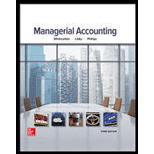
Identify and briefly describe the assumptions of CVP.
Introduction:
Cost-volume profit analysis is a tool that helps in decision making by establishing a relationship between volume, price, variable cost, fixed cost and profit.
To identify and describe:
The assumptions of CVP.
Answer to Problem 1Q
The assumptions of CVP are:
- Linear cost and revenue function
- Cost can be categorized as either fixed or variable
- Only volume affects total cost and total revenue.
- Volume of production is equals to volume of sales
- Product mix is constant
Explanation of Solution
The assumptions of CVP are:
Linear cost and revenue function:
A straight line is used to describe the relationship between total cost and sales volume and total revenue and sales volume.
Cost can be categorized as either fixed or variable:
To find mixed cost, we must determine total fixed cost and variable cost per unit.
Only volume affects total cost and total revenue:
Other factors such as employee learning curve, productivity gains etc. are ignored.
Volume of production is equals to volume of sales:
It is assumed that There will not be any change in beginning or ending inventory, it is assumed that all the units produced are sold during a period.
Product mix is constant:
The companies dealing in multiple products assumes that units sold, or sales revenue generated from each product or service line remains constant.
Want to see more full solutions like this?
Chapter 6 Solutions
MANAGERIAL ACCOUNTING >C<
- Please provide the solution to this financial accounting question using proper accounting principles.arrow_forwardCan you solve this financial accounting problem using appropriate financial principles?arrow_forwardHow can the accounting concept of materiality be applied to the recognition and disclosure of contingent liabilities?arrow_forward
- A local bakery sells 12,000 loaves of sourdough bread each year. The loaves are ordered from an outside supplier, and it takes 4 days for each shipment of loaves to arrive. Ordering costs are estimated at $18 per order. Carrying costs are $6 per loaf per year. Assume that the bakery is open 300 days a year. What is the maximum inventory of loaves held in a given ordering cycle?arrow_forwardI need assistance with this general accounting question using appropriate principles.arrow_forwardA local bakery sells 12,000 loaves of sourdough bread each year. The loaves are ordered from an outside supplier, and it takes 4 days for each shipment of loaves to arrive. Ordering costs are estimated at $18 per order. Carrying costs are $6 per loaf per year. Assume that the bakery is open 300 days a year. What is the maximum inventory of loaves held in a given ordering cycle? HELParrow_forward
- Solve thisarrow_forwardUse the information provided to answer following questions Dionne Rose is employed Garden Variety Ltd. in Jamaica. For the month of May, 2017, she received a gross salary of $350,000. She contributes 10% or her gross salary towards an approved pension scheme. As an employee, her statutory deductions include NIS, NHT and education tax. 1. What is Dionne’s NHT contribution? A.$7,000 B.$6,300 C.$6,237.50 D.$9,356.25 2. How much is Dionne’s taxable income? A.$228,519 B.$186,867 C.$189,992 D.$51,867 3. What would be Dionne’s net pay? A.$251,141.06 B.$240,728.06 C.$286,144.06 D.$278,853.06arrow_forwardPlease provide the correct answer to this financial accounting problem using accurate calculations.arrow_forward
- I am looking for help with this financial accounting question using proper accounting standards.arrow_forwardI am looking for the correct answer to this general accounting problem using valid accounting standards.arrow_forwardCan you explain this financial accounting question using accurate calculation methods?arrow_forward
 EBK CONTEMPORARY FINANCIAL MANAGEMENTFinanceISBN:9781337514835Author:MOYERPublisher:CENGAGE LEARNING - CONSIGNMENT
EBK CONTEMPORARY FINANCIAL MANAGEMENTFinanceISBN:9781337514835Author:MOYERPublisher:CENGAGE LEARNING - CONSIGNMENT Intermediate Financial Management (MindTap Course...FinanceISBN:9781337395083Author:Eugene F. Brigham, Phillip R. DavesPublisher:Cengage LearningPrinciples of Accounting Volume 2AccountingISBN:9781947172609Author:OpenStaxPublisher:OpenStax College
Intermediate Financial Management (MindTap Course...FinanceISBN:9781337395083Author:Eugene F. Brigham, Phillip R. DavesPublisher:Cengage LearningPrinciples of Accounting Volume 2AccountingISBN:9781947172609Author:OpenStaxPublisher:OpenStax College



